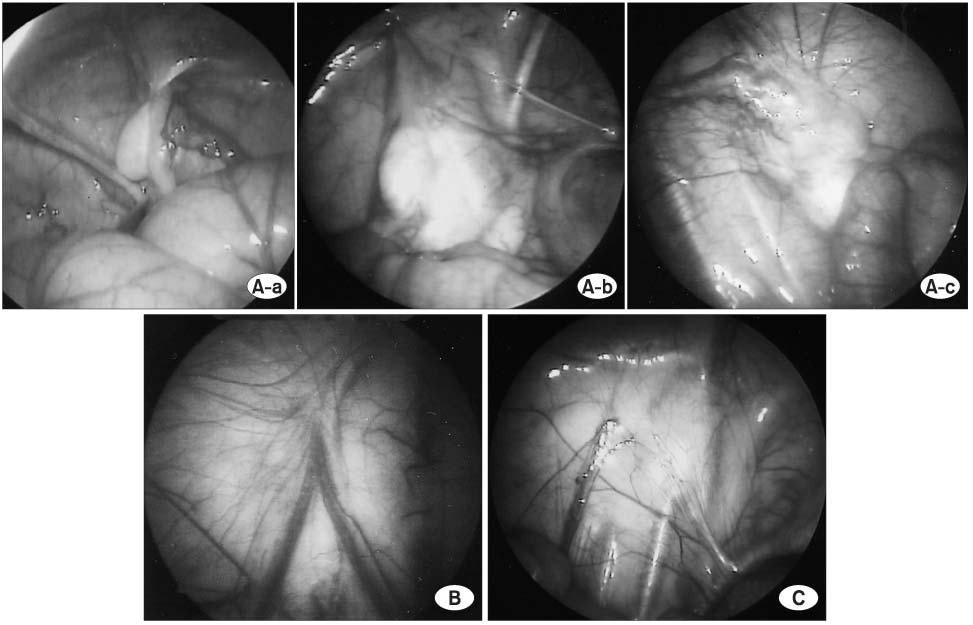Korean J Urol.
2006 Jul;47(7):762-768. 10.4111/kju.2006.47.7.762.
Guideline for the Surgical Diagnosis and Treatment of Nonpalpable Testis Based on Experiences with Laparoscopic Procedure
- Affiliations
-
- 1Department of Urology, Samsung Medical Center, Sungkyunkwan University School of Medicine, Seoul, Korea. khpark@smc.samsung.co.kr
- KMID: 2294319
- DOI: http://doi.org/10.4111/kju.2006.47.7.762
Abstract
-
PURPOSE: We assessed our laparoscopic experiences for the children with nonpalpable testis to evaluated the advantages of performing laparoscopy and we suggest a surgical management guideline for them.
MATERIALS AND METHODS
We retrospectively reviewed the medical records of a total of 83 children (97 testes) who underwent diagnostic laparoscopy for nonpalpable testes. We analyzed the surgical decisions and outcomes according to the laparoscopic findings.
RESULTS
On the laparoscopic examination, 48 (49.5%) testes were located in the abdominal cavity. We subsequently performed inguinal orchiopexy (28), laparoscopic orchiopexy (8), Fowler-Stephens orchiopexy (10, one or two stage), or orchiectomy (2). The other 40 (41.2%) were suspected to be testicular nubbin, and we managed this by excision of the testicular nubbin by the inguinal (29) or scrotal (10) approach, except for one viable testis in the inguinal canal. When blind-ending vessels were observed, we stopped the procedure under the diagnosis of vanishing testis in 9 cases (9.3%). The testicular survival rates were 92.6% (25/27) for inguinal orchiopexy, 100% (8/8) for laparoscopic orchiopexy and 60% (6/10) for Fowler-Stephen orchiopexy.
CONCLUSIONS
We preferred laparoscopic orchiopexy for treating intraabdominal testis when the location was > or=2.5cm from the internal ring. When the testicular location was closer to the internal ring, we recommend inguinal orchiopexy as a viable option. In cases with high riding testis or very short internal spermatic vessels, we recommend Fowler-Stephens orchiopexy. For the suspected testicular nubbin, we preferred trans-scrotal excision when the nubbin was identified in the scrotum. Otherwise, we recommend inguinal exploration.
Keyword
MeSH Terms
Figure
Reference
-
1. Hinman F Jr. Survey: localization and operation for nonpalpable testes. Urology. 1987. 30:193–198.2. Cortesi N, Ferrari P, Zambarda E, Manenti A, Baldini A, Morano FP. Diagnosis of bilateral abdominal cryptorchidism by laparoscopy. Endoscopy. 1976. 8:33–34.3. Lee AK, Yun JM, Park MS, Choi H. Therapeutic laparoscopy for impalpable testis. Korean J Urol. 1997. 38:848–854.4. Rozanski TA, Wojno KJ, Bloom DA. The remnant orchiectomy. J Urol. 1996. 155:712–713.5. Madrazo BL, Klugo RC, Parks JA, DiLoreto R. Ultrasonographic demonstration of undescended testes. Radiology. 1979. 133:181–183.6. Lee JK, McClennan BL, Stanley RJ, Sagel SS. Utility of computed tomography in the localization of the undescended testis. Radiology. 1980. 135:121–125.7. Won HS, Park KH, Lee SW, Chai SE. Predictive value of the contralateral testicular hypertrophy for testicular nubbin in patients with unilateral impalpable testis. Korean J Urol. 1999. 40:1549–1553.8. Chang B, Palmer LS, Franco I. Laparoscopic orchiopexy: a review of a large clinical series. BJU Int. 2001. 87:490–493.9. Samadi AA, Palmer LS, Franco I. Laparoscopic orchiopexy: report of 203 cases with review of diagnosis, operative technique, and lessons learned. J Endourol. 2003. 17:365–368.10. Mark SD, Davidson PJ. The role of laparoscopy in evaluation of the impalpable undescended testis. Aust N Z J Surg. 1997. 67:332–334.11. Baker LA, Docimo SG, Surer I, Peters C, Cisek L, Diamond DA, et al. A multi-institutional analysis of laparoscopic orchidopexy. BJU Int. 2001. 87:484–489.12. Choi KY, Park TH, Kim KS. Laparoscopic orchiopexy for intra-abdominal testis: complications and technical aspects. Korean J Urol. 2000. 41:420–424.13. Ferro F, Lais A, Bagolan P, Talamo M, Caterino S. Impact of primary surgical approach in the management of the impalpable testis. Eur Urol. 1992. 22:142–146.14. Lee DH, Kim KS. Impalpable testes: an experience of 97 surgically corrected cases. Korean J Urol. 2001. 42:1180–1184.15. Mikaelsson C, Arnbjornsson E, Lindhagen T, Montgomery A, Kullendorff CM. Routine laparoscopy for nonpalpable testes? J Laparoendosc Adv Surg Tech A. 1999. 9:239–241.16. Argos Rodriguez MD, Unda Freire A, Ruiz Orpez A, Garcia Lorenzo C. Diagnostic and therapeutic laparoscopy for nonpalpable testis. Surg Endosc. 2003. 17:1756–1758.17. Cisek LJ, Peters CA, Atala A, Bauer SB, Diamond DA, Retik AB. Current findings in diagnostic laparoscopic evaluation of the nonpalpable testis. J Urol. 1998. 160:1145–1149.18. Barqawi AZ, Blyth B, Jordan GH, Ehrlich RM, Koyle MA. Role of laparoscopy in patients with previous negative exploration for impalpable testis. Urology. 2003. 61:1234–1237.19. Snodgrass W, Chen K, Harrison C. Initial scrotal incision for unilateral nonpalpable testis. J Urol. 2004. 172:1742–1745.20. Gill IS, Ross JH, Sung GT, Kay R. Needlescopic surgery for cryptorchidism: the initial series. J Pediatr Surg. 2000. 35:1426–1430.
- Full Text Links
- Actions
-
Cited
- CITED
-
- Close
- Share
- Similar articles
-
- Preoperative Laparoscopic Localization and Assessment of the nonpalpable Testis
- Evaluation of diagnostic methods in children with nonpalpable undescended testis
- Single port laparoscopic orchidopexy in children using surgical glove port and conventional rigid instruments
- Laparoscopic Orchiopexy for a Nonpalpable Testis
- Laparoscopy for nonpalpable testes



